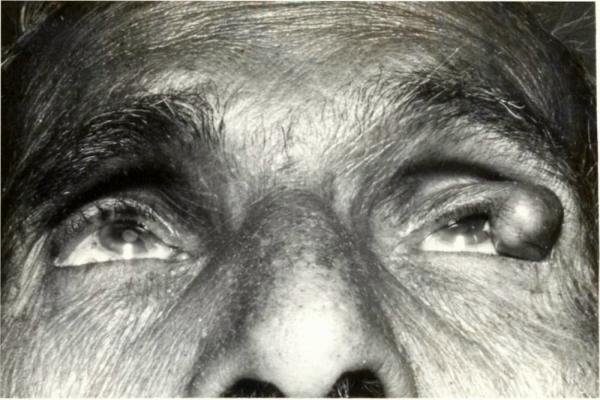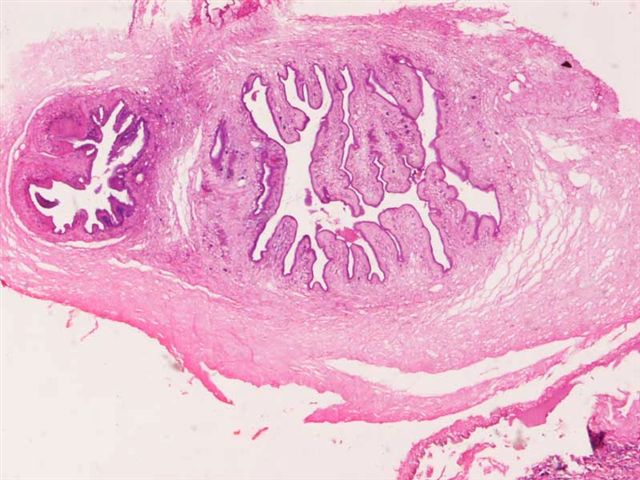10 April 2008 - Case #115
All cases are archived on our website. To view them sorted by case number, diagnosis or category, visit our main Case of the Month page. To subscribe or unsubscribe to Case of the Month or our other email lists, click here.
This case was contributed by Dr. Anshu Jain and Professor Veena Maheshwari in Aligarh, Uttarpradesh (India).
Case #115
Clinical history:
A 60 year old man presented with a progressive swelling in the left eyelid for 2 months. He was a non-pork eater and belonged to a low socioeconomic group. There was no history of headache or seizures. His left eyelid showed a 1.2 x 0.8 cm swelling. The physical exam was otherwise normal, with no swellings elsewhere. The eyelid lesion was excised.
Grossly, the mass was 1.5 x 1.0 cm and sectioning revealed two cystic spaces with a single solid focus on the inner surface.
Clinical image:
Microscopic images:
What is your diagnosis?
Diagnosis: Cysticercosis of the eyelid
Discussion:
Microscopic examination demonstrated the undulating laminated membranous wall of a cysticercus (the larvae of a tapeworm), with an associated inflammatory infiltrate and fibrosis (left side of image #1). The scolex (knoblike anterior hooked end that serves as an organ of attachment to the host) is present in image #2.
Cysticercosis is a systemic illness due to dissemination of the larval form of the pork tapeworm, Taenia solium. Encystment of larvae can occur in almost any tissue, including skin, skeletal muscle, heart, CNS (neurocysticercosis) and eye. Involvement of the eyelid is rare, with few reported cases (Arch Ophthalmol 1978;96:1255, Indian J Med Microbiol. 2007;25:214).
Cystercercosis affects 50 million people worldwide and is endemic in Mexico and South America, sub-Saharan Africa, India and East Asia. It is the most common cause worldwide of parasitic infestation of the CNS and a leading cause of seizures. In the U.S., there are an estimated 1000 annual new cases, with an increasing incidence due to immigration from and travel to endemic areas and improved diagnosis through imaging and serology.
Treatment is with albendazole, an antihelminth.
References: eMedicine: Cysticercosis in Emergency Medicine [Accessed 7 May 2024], CDC: Parasites - Cysticercosis [Accessed 7 May 2024], Wikipedia: Cysticercosis [Accessed 7 May 2024]
All cases are archived on our website. To view them sorted by case number, diagnosis or category, visit our main Case of the Month page. To subscribe or unsubscribe to Case of the Month or our other email lists, click here.
This case was contributed by Dr. Anshu Jain and Professor Veena Maheshwari in Aligarh, Uttarpradesh (India).
Case #115
Clinical history:
A 60 year old man presented with a progressive swelling in the left eyelid for 2 months. He was a non-pork eater and belonged to a low socioeconomic group. There was no history of headache or seizures. His left eyelid showed a 1.2 x 0.8 cm swelling. The physical exam was otherwise normal, with no swellings elsewhere. The eyelid lesion was excised.
Grossly, the mass was 1.5 x 1.0 cm and sectioning revealed two cystic spaces with a single solid focus on the inner surface.
Clinical image:
Microscopic images:
What is your diagnosis?
Click here for diagnosis and discussion:
Diagnosis: Cysticercosis of the eyelid
Discussion:
Microscopic examination demonstrated the undulating laminated membranous wall of a cysticercus (the larvae of a tapeworm), with an associated inflammatory infiltrate and fibrosis (left side of image #1). The scolex (knoblike anterior hooked end that serves as an organ of attachment to the host) is present in image #2.
Cysticercosis is a systemic illness due to dissemination of the larval form of the pork tapeworm, Taenia solium. Encystment of larvae can occur in almost any tissue, including skin, skeletal muscle, heart, CNS (neurocysticercosis) and eye. Involvement of the eyelid is rare, with few reported cases (Arch Ophthalmol 1978;96:1255, Indian J Med Microbiol. 2007;25:214).
Cystercercosis affects 50 million people worldwide and is endemic in Mexico and South America, sub-Saharan Africa, India and East Asia. It is the most common cause worldwide of parasitic infestation of the CNS and a leading cause of seizures. In the U.S., there are an estimated 1000 annual new cases, with an increasing incidence due to immigration from and travel to endemic areas and improved diagnosis through imaging and serology.
Treatment is with albendazole, an antihelminth.
References: eMedicine: Cysticercosis in Emergency Medicine [Accessed 7 May 2024], CDC: Parasites - Cysticercosis [Accessed 7 May 2024], Wikipedia: Cysticercosis [Accessed 7 May 2024]




